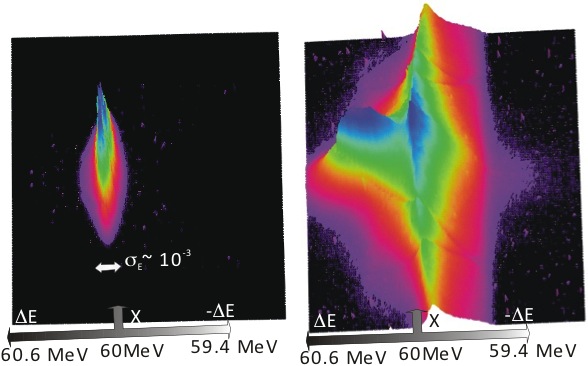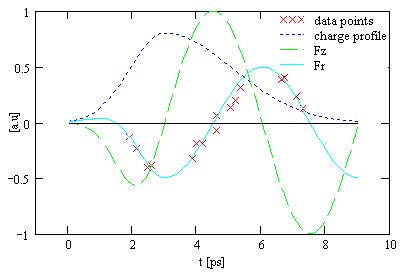- Home
- Capabilities
- Science Highlights
- Operations
- Publications
-
ES&H
- Experiment Start-up
- Laser Safety
Collider-Accelerator Dept.
- C-AD ES&H Resources
- Staff
- Users' Place
- Apply for Access
First Demonstration of Phasing between longitudinal and transverse Plasma Wake Fields
Afteran initial experiment on CO2 laser channeling, the same plasma source was used for transmitting the e-beam for the purpose of observing and studying the effects of plasma wakefields. Figure 1 illustrates the electron distributions recorded with a spectrometer placed after the capillary.;
The horizontal axis shows the electrons’ energy span, and the vertical axis represents the size of the transverse e-beam that is proportional to its angular divergence. Figure 1a shows the ebeam’s initial energy spread, and transverse dimensions. Figure 1b was obtained with the capillary discharge, and demonstrates that part of the beam loses energy while other parts gain it. At the same time, the e-beam is focused or de-focused in a particular pattern that is correlated with the energy gain.
Figure 1. Electron density distributions on a spectrometer reveal the 900 phase shift between the longitudinaland transverse components in the plasma wake:

(a) e-beam distribution obtained without plasma; (b) e-beam after passing the plasma

(c)Theoretical and experimental temporal plots: Dotted line e-beam pulse (experimental), dashed line - longitudinal Wakefield (theoretical), solid line - transverse Wakefield (theoretical), crosses - experimental points.
The leading edge of the electron bunch excites a plasma wake. It was predicted, but never experimentally proved, that the transverse force in the plasma wake has a 900 offset from the longitudinal force (Figure 1c). Then, depending upon the wakefield’s phase, electrons with the same longitudinal momentum form two groups: 1). focused and 2). de-focused. This explains why the best fit to the corresponding vertical slices from the spectral distribution in Figure 1b is a superposition of two Gaussian distributions. From the width of the individual Gaussian distribution for each group of electrons, we reconstructed the transverse force, and obtained a perfect fit to the theoretical dependence (indicated with crosses in figure 1c). This finding confirms the prediction of a phase offset between the accelerating and focusing components of a plasma wake.
This first plasma wakefield experiment demonstrated the added ATF capability in conducting a new class of beam experiments that immediately was recognized by the ATF users. Proposals on series of plasma-based studies followed, and highly successful new classes of user experiments were launched. The ATF plasma source, combined with a high-brightness linac beam became the test bed for comprehensive studies of a whole variety of the electron bunch’s modulation longitudinally, transversely, and by its momentum as summarized in Figure 2.

Figure 2. Different regimes of e-beam/plasma interaction investigated in a string of ATF user experiments
Yakimenko, V., et al., Cohesive Acceleration and Focusing of Relativistic Electrons in Overdense Plasma. Phys Rev Lett, 2003. 91(1): p. 014802.78.




